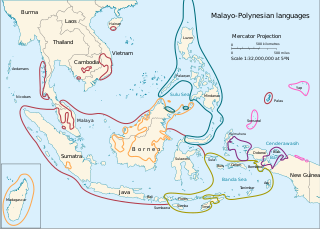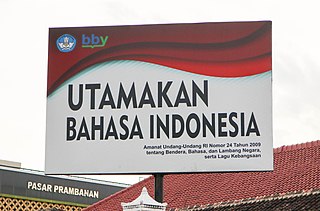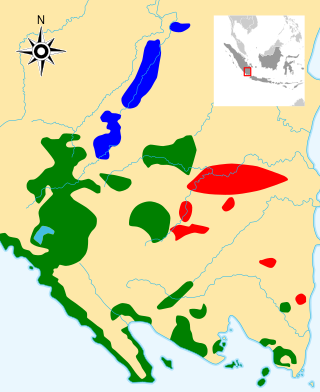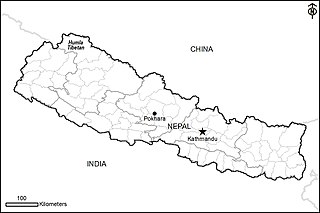
The Malayo-Polynesian languages are a subgroup of the Austronesian languages, with approximately 385.5 million speakers. The Malayo-Polynesian languages are spoken by the Austronesian peoples outside of Taiwan, in the island nations of Southeast Asia and the Pacific Ocean, with a smaller number in continental Asia in the areas near the Malay Peninsula, with Cambodia, Vietnam and the Chinese island Hainan as the northwest geographic outlier. Malagasy, spoken in the island of Madagascar off the eastern coast of Africa in the Indian Ocean, is the furthest western outlier.

Malay is an Austronesian language that is an official language of Brunei, Indonesia, Malaysia, and Singapore, and that is also spoken in East Timor and parts of Thailand. Altogether, it is spoken by 290 million people across Maritime Southeast Asia.

Javanese is a Malayo-Polynesian language spoken by the Javanese people from the central and eastern parts of the island of Java, Indonesia. There are also pockets of Javanese speakers on the northern coast of western Java. It is the native language of more than 98 million people.

Minangkabau is an Austronesian language spoken by the Minangkabau of West Sumatra, the western part of Riau, South Aceh Regency, the northern part of Bengkulu and Jambi, also in several cities throughout Indonesia by migrated Minangkabau. The language is also a lingua franca along the western coastal region of the province of North Sumatra, and is even used in parts of Aceh, where the language is called Aneuk Jamee.
In addition to its classical and literary form, Malay had various regional dialects established after the rise of the Srivijaya empire in Sumatra, Indonesia. Also, Malay spread through interethnic contact and trade across the south East Asia Archipelago as far as the Philippines. That contact resulted in a lingua franca that was called Bazaar Malay or low Malay and in Malay Melayu Pasar. It is generally believed that Bazaar Malay was a pidgin, influenced by contact among Malay, Hokkien, Portuguese, and Dutch traders.

The South Slavic languages are one of three branches of the Slavic languages. There are approximately 30 million speakers, mainly in the Balkans. These are separated geographically from speakers of the other two Slavic branches by a belt of German, Hungarian and Romanian speakers.

Surigaonon is an Austronesian language spoken by Surigaonon people. As a regional Philippine language, it is spoken in the province of Surigao del Norte, Dinagat Islands, Surigao del Sur, and some portions of Agusan del Norte, especially the towns near Lake Mainit, Agusan del Sur and Davao Oriental.
A macrolanguage is a book-keeping mechanism for the ISO 639 international standard of language codes. Macrolanguages are established to assist mapping between different sets of ISO language codes. Specifically, there may be a many-to-one correspondence between ISO 639-3, intended to identify all the thousands of languages of the world, and either of two other sets, ISO 639-1, established to identify languages in computer systems, and ISO 639-2, which encodes a few hundred languages for library cataloguing and bibliographic purposes. When such many-to-one ISO 639-2 codes are included in an ISO 639-3 context, they are called "macrolanguages" to distinguish them from the corresponding individual languages of ISO 639-3. According to the ISO,
Some existing code elements in ISO 639-2, and the corresponding code elements in ISO 639-1, are designated in those parts of ISO 639 as individual language code elements, yet are in a one-to-many relationship with individual language code elements in [ISO 639-3]. For purposes of [ISO 639-3], they are considered to be macrolanguage code elements.

The Malayic languages are a branch of the Malayo-Polynesian subgroup of the Austronesian language family. The most prominent member is Malay, which is the national language of Brunei, Singapore and Malaysia, and is the basis for Indonesian, the national language of Indonesia. The Malayic branch also includes the local languages spoken by ethnic Malays, further several languages spoken by various other ethnic groups of Sumatra, Indonesia and Borneo. The most probable candidate for the urheimat of the Malayic languages is western Borneo.

More than 700 living languages are spoken in Indonesia. This figure indicates that Indonesia has about 10% of the world's languages, establishing its reputation as the second most linguistically diverse nation in the world after Papua New Guinea. Most languages belong to the Austronesian language family, while there are over 270 Papuan languages spoken in eastern Indonesia. The language most widely spoken as a native language is Javanese.

Lampung or Lampungic is an Austronesian language or dialect cluster with around 1.5 million native speakers, who primarily belong to the Lampung ethnic group of southern Sumatra, Indonesia. It is divided into two or three varieties: Lampung Api, Lampung Nyo, and Komering. The latter is sometimes included in Lampung Api, sometimes treated as an entirely separate language. Komering people see themselves as ethnically separate from, but related to, Lampung people.
The Ulu scripts, locally known as Surat Ulu are a family of writing systems found in central and south Sumatra, in the regions of Kerinci, Bengkulu, Palembang and Lampung, Indonesia. They were used to write manuscripts in Sumatran languages and Malay, such as the Tanjung Tanah Code of Law. The Malay writing was gradually replaced by the Jawi script, a localized version of the Arabic script.
Palembang, also known as Palembang Malay, or Musi, is a Malayic language primarily spoken in about two thirds of South Sumatra Province in Indonesia, especially along the Musi River. It consists of two separate but mutually intelligible dialect chains: Musi and Palembang. The urban Palembang dialect is a koiné that emerged in Palembang, the capital city of South Sumatra. It has become a lingua franca throughout major population centers in the province, and is often used polyglossically with Indonesian and other regional languages and dialects in the area. Since parts of South Sumatra used to be under direct Malay and Javanese rule for quite a long time, the speech varieties of Palembang and its surrounding area are significantly influenced by Malay and Javanese, down to their core vocabularies.
Urak Lawoi’ or Urak Lawoc is a Malayic language spoken in southern Thailand.
Nasal is an Austronesian language of southwestern Sumatra.

Helong is a Central Malayo-Polynesian language of West Timor. Speakers are interspersed with those of Amarasi. This language has become endangered as a result of its native speakers marrying those who do not speak Helong, and as a result of coming in contact with the outside community. Helong speakers are found in four villages on the South-Western coast of West Timor, as well as on Semau Island, a small island just off the coast of West Timor. The mostly Christian, slightly patriarchal society of Semau do their best to send their children away to Bali to earn money to send home.

Rejang people are an Austronesian ethnolinguistic group, native to the some parts of Bengkulu Province and South Sumatera Province in the southwestern part of Sumatera Island, Indonesia. They occupied some area in a cool mountain slopes of the Barisan mountain range in both sides of Bengkulu and South Sumatra. With approximately more than 1,3 million people, they form the largest ethnic group in Bengkulu Province. Rejang people predominantly live as a majority in 5 out 10 regencies and city of Bengkulu Province, while the rest of them who lives in South Sumatera resides at 7 villages in the district called as Bermani Ulu Rawas. The Rejangs are predominantly an Islam adherent group with small numbers following a religion other than Islam. According to research, Rejang people are the descendants of the Bukar-Sadong people who migrated from Northern Borneo (Sarawak).
Rejang is an Austronesian language predominantly spoken by the Rejang people in southwestern parts of Sumatra (Bengkulu), Indonesia. There are five dialects, spread from mountainous region to the coastal region of Bengkulu, including the Musi (Musai) dialect, the Lebong dialect, the Kebanagung dialect, the Rawas (Awes) dialect, and the Pesisir dialect.
The Moklenic or Moken–Moklen languages consist of a pair of two closely related but distinct languages, namely Moken and Moklen. Larish (1999) establishes the two languages as forming two distinct subgroups of a larger Moken–Moklen branch. Larish (2005) suggests Moklenic as an alternative name for Moken–Moklen, the latter term which was originally used by Larish (1999).

Humla Tibetan, also known as Humla Bhotiya, and Humli Tamang, is the Sino-Tibetan language of the Tibetan people of Humla district in Nepal.












